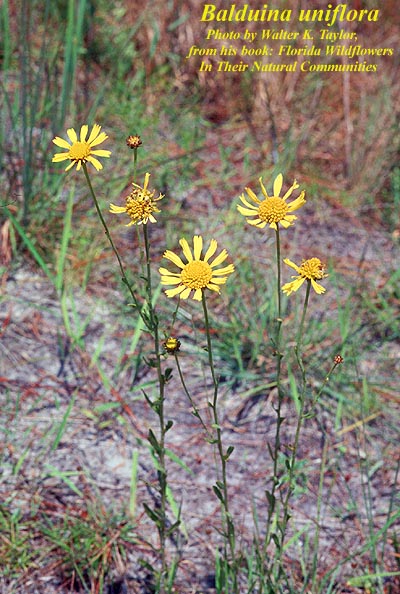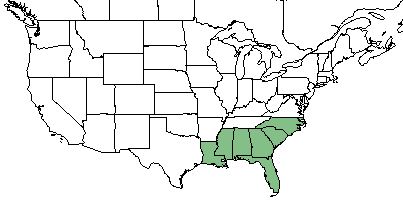Difference between revisions of "Balduina uniflora"
Lsandstrum (talk | contribs) |
Lsandstrum (talk | contribs) |
||
| Line 32: | Line 32: | ||
==Ecology== | ==Ecology== | ||
===Habitat=== <!--Natural communities, human disturbed habitats, topography, hydrology, soils, light, fire regime requirements for removal of competition, etc.--> | ===Habitat=== <!--Natural communities, human disturbed habitats, topography, hydrology, soils, light, fire regime requirements for removal of competition, etc.--> | ||
| − | This species is found in wet pine savannas, pine flatwoods,<ref name="Weakley 2015"/> and the margins of pitcher-plant bogs.<ref name="Parker & Jones 1975">Parker ES, Jones SB (1975) A systematic study of the genus ''Balduina'' (Compositae, Heliantheae). Brittonia 27(4):355-361.</ref> It has also been observed in moist sand roadsides, wet peaty soil in pocosin, swamps, and mesic disturbed sites.<ref name= "Herbarium">Florida State University Robert K. Godfrey Herbarium database. URL: http://herbarium.bio.fsu.edu. Last accessed: March 2019. Collectors: Loran C. Anderson, L. E. Arnold, Wendy Casper, A. F. Clewell, A. H. Curtiss, M. Darst, Donald Davidson, M. Davis, R. K. Godfrey, Floyd Griffith, Bruce Hansen, JoAnn Hansen, Ann F. Johnson, Lisa Keppner, R. Kral, R. A. Norris, Katelin D. Pearson, R. E. Perdue, Jr., Paul R. Redfearn, Jr., Bob Rice, E. L. Tyson, D. B. Ward, Rodie White, and Lovett E. Williams. States and Counties: Florida: Bay, Calhoun, Duval, Escambia, Franklin, Jackson, Leon, Nassau, Okaloosa, Santa Rosa, St Johns, Volusia, Wakulla, Walton, and Washington. Georgia: Grady, Thomas, and Worth.</ref> ''B. uniflora'' does not respond to soil disturbance by clearcutting and chopping in North Florida flatwoods forests.<ref>Moore, W.H., B.F. Swindel, and W.S. Terry. ( | + | This species is found in wet pine savannas, pine flatwoods,<ref name="Weakley 2015"/> and the margins of pitcher-plant bogs.<ref name="Parker & Jones 1975">Parker ES, Jones SB (1975) A systematic study of the genus ''Balduina'' (Compositae, Heliantheae). Brittonia 27(4):355-361.</ref> It has also been observed in moist sand roadsides, wet peaty soil in pocosin, swamps, and mesic disturbed sites.<ref name= "Herbarium">Florida State University Robert K. Godfrey Herbarium database. URL: http://herbarium.bio.fsu.edu. Last accessed: March 2019. Collectors: Loran C. Anderson, L. E. Arnold, Wendy Casper, A. F. Clewell, A. H. Curtiss, M. Darst, Donald Davidson, M. Davis, R. K. Godfrey, Floyd Griffith, Bruce Hansen, JoAnn Hansen, Ann F. Johnson, Lisa Keppner, R. Kral, R. A. Norris, Katelin D. Pearson, R. E. Perdue, Jr., Paul R. Redfearn, Jr., Bob Rice, E. L. Tyson, D. B. Ward, Rodie White, and Lovett E. Williams. States and Counties: Florida: Bay, Calhoun, Duval, Escambia, Franklin, Jackson, Leon, Nassau, Okaloosa, Santa Rosa, St Johns, Volusia, Wakulla, Walton, and Washington. Georgia: Grady, Thomas, and Worth.</ref> ''B. uniflora'' does not respond to soil disturbance by clearcutting and chopping in North Florida flatwoods forests.<ref>Moore, W.H., B.F. Swindel, and W.S. Terry. (1982). Vegetative Response to Clearcutting and Chopping in a North Florida Flatwoods Forest. Journal of Range Management 35(2):214-218.</ref> |
Associated species: ''Liatris'' sp., ''Sporobolus'' sp., ''Andropogon'' sp., ''Schizachyrium'' sp., ''Eupatorium'' sp., ''Pinus palustris'', ''Habenaria ciliaris'', ''Lilium catesbaei'', ''Eragrostis elliottii'', ''Eriocaulon decangulare'', ''Rhynchospora'' sp., ''Bigelowia'' sp., ''Hypericum'' sp., ''Serenoa repens'', ''Xyris flexuosa'', ''Sabatia brevifolia'', ''Kalmia hirsute'', ''Polygala lutea'', ''Sorghastrum secundum'', ''Quercus pumila'', ''Seymeria cassioides'', ''Helianthus heterophyllus'', ''Juncus'' sp., ''Ilex glabra'', ''Rhexia'' sp., ''Marshallia graminifolia'', ''Pityopsis'' sp., and ''Carex'' sp.<ref name= "Herbarium"/> | Associated species: ''Liatris'' sp., ''Sporobolus'' sp., ''Andropogon'' sp., ''Schizachyrium'' sp., ''Eupatorium'' sp., ''Pinus palustris'', ''Habenaria ciliaris'', ''Lilium catesbaei'', ''Eragrostis elliottii'', ''Eriocaulon decangulare'', ''Rhynchospora'' sp., ''Bigelowia'' sp., ''Hypericum'' sp., ''Serenoa repens'', ''Xyris flexuosa'', ''Sabatia brevifolia'', ''Kalmia hirsute'', ''Polygala lutea'', ''Sorghastrum secundum'', ''Quercus pumila'', ''Seymeria cassioides'', ''Helianthus heterophyllus'', ''Juncus'' sp., ''Ilex glabra'', ''Rhexia'' sp., ''Marshallia graminifolia'', ''Pityopsis'' sp., and ''Carex'' sp.<ref name= "Herbarium"/> | ||
Revision as of 18:09, 22 July 2019
| Balduina uniflora | |
|---|---|

| |
| Photo by Altas of Florida Plants Database | |
| Scientific classification | |
| Kingdom: | Plantae |
| Division: | Magnoliophyta - Flowering plants |
| Class: | Magnoliopsida - Dicots |
| Order: | Asterales |
| Family: | Asteraceae |
| Genus: | Balduina |
| Species: | B. uniflora |
| Binomial name | |
| Balduina uniflora Nutt. | |

| |
| Natural range of Balduina uniflora from USDA NRCS Plants Database. | |
Common Names: Savanna Honeycomb-head; Yellow Balduina;[1] Oneflower Honeycombhead[2]
Contents
Taxonomic Notes
Synonyms: Endorima uniflora (Nuttall) Rafinesque [1]
Varieties: none
Description
Balduina uniflora is a dioecious perennial that grows as a forb/herb.[2] Its roots are fleshy[3] and have a mean depth of 15.75 cm and porosity of 0.0%.[4] It reproduces vegetatively from root stocks and can reach heights of 0.7-1.0 m. Inflorescence contain 1-3 heads, each with ray flowers 8-22, 5.5-8.2 mm long and 1-2 mm wide. Flowers are yellow.[3]
Distribution
It is found from eastern Louisiana, eastward throughout the panhandle of Florida and southeastern Georgia, and northward to southeastern North Carolina.[2]
Ecology
Habitat
This species is found in wet pine savannas, pine flatwoods,[1] and the margins of pitcher-plant bogs.[3] It has also been observed in moist sand roadsides, wet peaty soil in pocosin, swamps, and mesic disturbed sites.[5] B. uniflora does not respond to soil disturbance by clearcutting and chopping in North Florida flatwoods forests.[6]
Associated species: Liatris sp., Sporobolus sp., Andropogon sp., Schizachyrium sp., Eupatorium sp., Pinus palustris, Habenaria ciliaris, Lilium catesbaei, Eragrostis elliottii, Eriocaulon decangulare, Rhynchospora sp., Bigelowia sp., Hypericum sp., Serenoa repens, Xyris flexuosa, Sabatia brevifolia, Kalmia hirsute, Polygala lutea, Sorghastrum secundum, Quercus pumila, Seymeria cassioides, Helianthus heterophyllus, Juncus sp., Ilex glabra, Rhexia sp., Marshallia graminifolia, Pityopsis sp., and Carex sp.[5]
Phenology
In the southeastern and mid-Atlantic United States, flowering occurs from late July through September.[1] Another, study reports flowering starting in June.[3] It has been observed to flower from November to Janurary, March and April, and July through September, with peak inflorescence in September.[7]
Seed dispersal
This species is thought to be dispersed by wind. [8]
Fire ecology
In Mississippi pine barrens, flowering increased significantly from one year after a burn into the second year following a burn.[9]
Pollination
It attracts bumblebees and butterflies which pollinates it.[10] Pollen grains are 40-45 µm in diameter.[3]
Use by animals
Henslow's sparrows were observed to eat B. uniflora as a part of their diet.[11]
Conservation and Management
Cultivation and restoration
Photo Gallery
References and notes
- ↑ 1.0 1.1 1.2 1.3 Weakley AS (2015) Flora of the Southern and Mid-Atlantic States. Chapel Hill, NC: University of North Carolina Herbarium.
- ↑ 2.0 2.1 2.2 USDA NRCS (2016) The PLANTS Database (http://plants.usda.gov, 26 January 2018). National Plant Data Team, Greensboro, NC 27401-4901 USA.
- ↑ 3.0 3.1 3.2 3.3 3.4 Parker ES, Jones SB (1975) A systematic study of the genus Balduina (Compositae, Heliantheae). Brittonia 27(4):355-361.
- ↑ Brewer JS, Baker DJ, Nero AS, Patterson AL, Robers RS, Turner LM (2011) Carnivoory in plants as a beneficial trait in wetlands. Aquatic Botany 94:62-70.
- ↑ 5.0 5.1 Florida State University Robert K. Godfrey Herbarium database. URL: http://herbarium.bio.fsu.edu. Last accessed: March 2019. Collectors: Loran C. Anderson, L. E. Arnold, Wendy Casper, A. F. Clewell, A. H. Curtiss, M. Darst, Donald Davidson, M. Davis, R. K. Godfrey, Floyd Griffith, Bruce Hansen, JoAnn Hansen, Ann F. Johnson, Lisa Keppner, R. Kral, R. A. Norris, Katelin D. Pearson, R. E. Perdue, Jr., Paul R. Redfearn, Jr., Bob Rice, E. L. Tyson, D. B. Ward, Rodie White, and Lovett E. Williams. States and Counties: Florida: Bay, Calhoun, Duval, Escambia, Franklin, Jackson, Leon, Nassau, Okaloosa, Santa Rosa, St Johns, Volusia, Wakulla, Walton, and Washington. Georgia: Grady, Thomas, and Worth.
- ↑ Moore, W.H., B.F. Swindel, and W.S. Terry. (1982). Vegetative Response to Clearcutting and Chopping in a North Florida Flatwoods Forest. Journal of Range Management 35(2):214-218.
- ↑ Nelson, G. PanFlora: Plant data for the eastern United States with emphasis on the Southeastern Coastal Plains, Florida, and the Florida Panhandle. www.gilnelson.com/PanFlora/ Accessed: 26 MAR 2019
- ↑ Kirkman, L. Katherine. Unpublished database of seed dispersal mode of plants found in Coastal Plain longleaf pine-grasslands of the Jones Ecological Research Center, Georgia.
- ↑ Hinman SE, Brewer JS (2007) Responses of two frequently-burned wet pine savannas to an extended period without fire. Journal of the Torrey Botanical Society 134(4):512-526.
- ↑ Pitts-Singer TL, Hanula JL, Walker JL (2002) Insect pollinators of three rare plants in a Florida longleaf pine forest. Florida Entomologist 85(2):308-316.
- ↑ DiMiceli, J. K., et al. (2007). "Seed preferences of wintering Henslow's sparrows." Condor 109: 595-604.